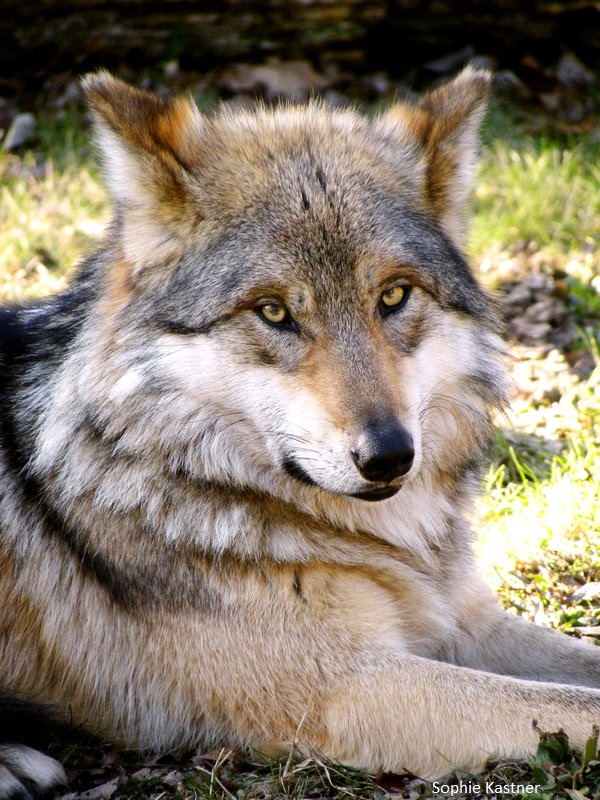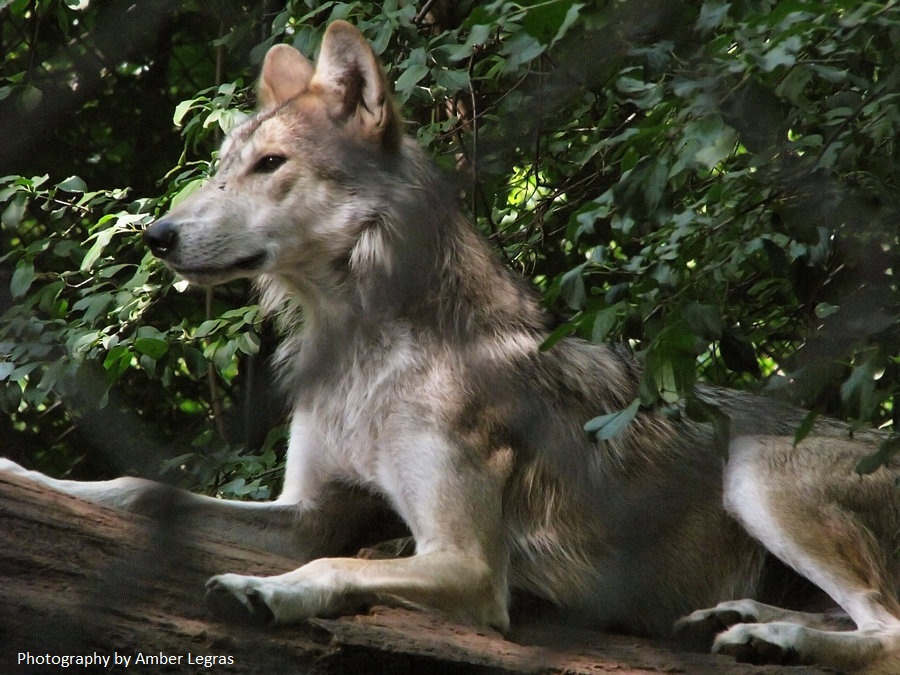In the Press: Will the Mexican Wolf Again Become Part of Mexico’s Wildlife?
 by Miguel A. Armella, Ph.D.
by Miguel A. Armella, Ph.D.
Mexican Wolves Released in Sonora
All of the efforts being made in Mexico have recently culminated in the release of Mexican wolves in Mexico. On October 11 in Sierra de San Luis in the northern part of the State of Sonora not far from the U.S. border, five Mexican wolves were released, starting a new chapter in Mexican wolf conservation in Mexico. Keeping the wolves alive will now become the main focus.
The Mexican wolf (Canis lupus baileyi), the smallest and most distinctive of North American wolves disappeared from Mexico’s wild landscape probably by the late 1970s.
Similar to what has happened in much of the world with other wolves, ranchers’ hunting and poisoning of the animals has caused their near-extinction, but they reached the southern State of Oaxaca (see map for original and proposed range) by following the top of the Sierra Madre (east and west) mountain range.
By 1976 a former American wolf trapper, Roy McBride, hired by the U.S. Fish and Wildlife Service (USFWS) under the Endangered Species Act (ESA), captured five males and one pregnant female in Mexico to start a breeding program. To do so, he needed the Mexican government’s collaboration; this resulted in the formation of the binational Mexican Gray Wolf Recovery Team.
Since then and with the participation of many people, Mexico has kept a recovery program active, participating in the exchange of animals for the breeding program, performing genetic and reproduction research, and running educational programs along the north and center of the country where wolves once lived.
The situation today
Currently 17 Mexican facilities— zoos, exhibition parks and prerelease facilities—participate in the program. These facilities in conjunction with researchers from universities, veterinarians, non-governmental organizations and other interested people have formed a group to work not only on increasing the number of animals but also on ensuring their genetic strength. Meetings are held annually with American counterparts, alternating between the two countries. In 2011 the meeting took place in July in Mexico City.
 According to the 2011 Mexican Wolf Studbook (Siminski, 2011), by 2011 there were 312 Mexican wolves with 67 (38 females and 29 males) in Mexican facilities. The non-governmental Organizaciòn de Vida Silvestre (OVIS) based in Monterrey, Nuevo Leon, developed, especially for this project, an intense rehabilitation program teaching these captive wolves to hunt for wildlife and make them less reliant on domestic prey. This program has had excellent success, with several packs now ready for life in the wild.
According to the 2011 Mexican Wolf Studbook (Siminski, 2011), by 2011 there were 312 Mexican wolves with 67 (38 females and 29 males) in Mexican facilities. The non-governmental Organizaciòn de Vida Silvestre (OVIS) based in Monterrey, Nuevo Leon, developed, especially for this project, an intense rehabilitation program teaching these captive wolves to hunt for wildlife and make them less reliant on domestic prey. This program has had excellent success, with several packs now ready for life in the wild.
Mexico’s president gives wolves a boost
Reintroduction efforts were stimulated in early 2007 when the just-inaugurated President Felipe Calderon named the Mexican wolf one of five priority species for conservation (along with the jaguar, golden eagle, sea turtle and marine caw). State-of-the-art technology and international experts were used to predict the best sites for reintroduction, and six areas were selected (see map). The Ministry of Natural Resources and Environment (abbreviated SEMARNAT in Spanish) sponsored detailed research in six locations to determine prey availability and public opinion about possible reintroduction.
From the survey of prey sponsored by SEMARANAT in 2008, one area located between the states of Sonora and Chihuahua was selected as the first priority to release wolves soon.
However, these surveys and more recent ones show the general public is not well informed about the conservation status of the Mexican gray wolf, although people are concerned about environmental conservation overall, and most support reintroduction and agree that the wolf must be rescued for ecological and ethical reasons.
Differences can be seen between rural and urban populations, however, with rural people less in favor of wolf reintroduction, especially in the north where cattle are still an important part of life. But even there perceptions differ. People over 60 years of age oppose wolf reintroduction; most claim to know about wolf attacks on humans or cattle, although few have witnessed one first hand. Younger people more readily accept options to preserve wolves, like reparation for loss of livestock and other financial incentives offered to ranchers.
Other challenges exist. Unlike in the United States, in Mexico there are no public lands, and federal or state parks are not big enough to hold wolf populations. Landowners must agree before wolves can be released within their property. Non-governmental organizations (like Naturalia A.C.) working in the area have had success communicating with some cattle-raising communities, especially using education programs with children. However, some ranchers who retain attitudes from the 1960s are using political power to stop the program regardless of the benefits offered. In spite of this opposition, some ranchers have individually agreed not to kill wolves within their ranch boundaries, and others are willing to let wolves live on their property, thus providing enough contiguous land to keep at least a handful of wolf packs in the area.
 While in the Northwest the social will is in question, new hope came during the last binational meeting when a group of ejidatarios (farmers holding common land) from southern Nuevo Leon said they are prepared to receive wolves. They have been working for three or four years getting funds from government programs to improve the environment with the idea of developing ecotourism. They know it will not be an easy task, but they believe they can benefit. They and the communities they represent know the importance of restoring natural balance and believe there is room in nature for everyone. This is a new plan and is being evaluated by environmental authorities.
While in the Northwest the social will is in question, new hope came during the last binational meeting when a group of ejidatarios (farmers holding common land) from southern Nuevo Leon said they are prepared to receive wolves. They have been working for three or four years getting funds from government programs to improve the environment with the idea of developing ecotourism. They know it will not be an easy task, but they believe they can benefit. They and the communities they represent know the importance of restoring natural balance and believe there is room in nature for everyone. This is a new plan and is being evaluated by environmental authorities.
Mexican wolves’ reintroduction has been a long walk; however, thanks to the hard work of the government, academics, non-governmental organizations and many other people reintroduction is getting closer. A new walk to maintain wolf populations in relative harmony with humans will start again, but most important is the acknowledgment that the Mexican wolf has a place in its own country.
Acknowledgment
Siminski, P. D., 2011. Mexican Wolf, Canis lupus baileyi, International Studbook. The Living Dessert, Palm Desert, California.
Miguel A. Armella, Ph.D., is a full professor and former head of the biology department at the Metropolitan Autonomous University (Universidad Autónoma Metropolitana), which is housed at a campus in Iztapalapa, a section of Mexico City. He has worked on the Mexican wolf recovery team since 2001 as an information and education officer.
************************************************************************************
You can read this article in its original format and view the maps and other images here.
To learn how you can help get more Mexican wolves in the wild where they belong, click here.
Photographs courtesy of Amber Legras and Sophie Kastner



